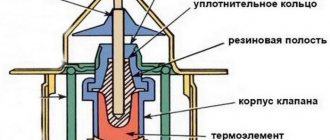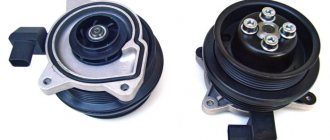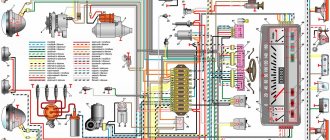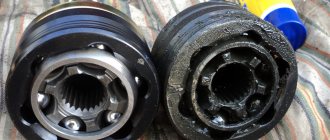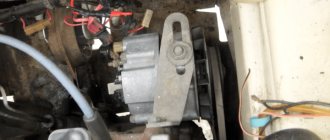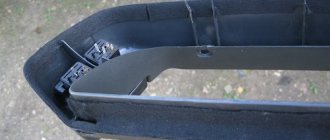The thermostat is an integral element of the cooling system of the VAZ-2110, requiring careful care, performance monitoring and timely replacement.
In this article we will consider the following questions:
- What is a thermostat, and what are the features of its operation?
- What engines are installed on various modifications of the VAZ-2110?
- How to recognize a device malfunction?
- How to replace on injection and carburetor cars?
- How to check performance, and what pitfalls are possible?
- Should you do the work yourself or trust the professionals?
The information provided is sufficient to promptly identify the malfunction, decide on further actions and replace the failed device.
Purpose of the VAZ-2110 thermostat, design and principle of operation
Thermostat is a unit installed in the car’s cooling system that regulates the direction of coolant in a large and small circle (depending on the engine temperature).
The node performs two tasks:
- Helps the engine warm up faster in cold weather;
- Eliminates the risk of overheating.
Both functions are realized thanks to temperature control and the ability of the main valve to change its position (open or close under the action of the trigger element).
Structurally, the VAZ 2110 thermostat is a unit with a cylindrical cross-section and three, five or six outputs, depending on the design.
Main exits:
- To the pump;
- From the radiator;
- From the engine.
The functionality of the device is ensured by the following elements:
- Bypass valve;
- Main valve and its spring;
- Piston and its holder;
- Heat sensitive composition;
- Bypass valve spring.
Operating principle:
- Inside the device there is a valve with a special substance inside, which expands (contracts) as the temperature increases (decreases).
- When a certain temperature level is reached (80.6-81.5 degrees Celsius), the mentioned substance presses on the valve, gradually opens it and directs the flow of coolant through the outlet pipe to the radiator (large circle).
When 94 degrees Celsius is reached, the main valve opens to its maximum (about six millimeters), and the bypass valve closes. - At low temperatures, the thermostat bypass valve is in the open position (the main one is closed), and the coolant flows in a small circle (without the participation of the radiator). This ensures quick warm-up of the engine.
Read more about the principle of operation of the thermostat here.
A stuck or other valve malfunction can cause the following problems:
- Overheating of the motor with the ensuing consequences;
- Inability of the power unit to reach the required temperature (relevant in winter).
Main functions
The operation of a thermostat involves maintaining a certain temperature level through the operation of thermostats or through a phase transition. Often there are thermally insulated devices designed to reduce heat or cold loss. The most common equipment that everyone uses is the refrigerator. The thermostat actually performs the function of preventing antifreeze from reaching the radiator while the engine is warming up. This simple mechanism underlies the increase in engine service life. After it has warmed up to the required temperature (90-95 C), the damper opens and the coolant begins to perform its function, normalizing the temperature. At home, you can set up an experiment where you will have the opportunity to observe a similar process. You need to fill the container with plain water, place the thermostat in there, and put it on the stove to heat up. As the volume of water expands and increases, the damper valve will open approximately a couple of centimeters. For the purity of the experiment, it is desirable to use a new mechanism.
What engines does the VAZ 2110 come with?
The VAZ-2110 car has been produced since 1996. At the same time, the power part gradually underwent changes:
- 21100 - base model produced in 1996-2000. The car was equipped with an engine with 8 valves and a volume of 1.5 liters (power 69 hp);
- 21101 is a model produced since 2004. Engine - injection, 1.6 liters, 8 valves;
- 21102 - 8-valve engine, 1.5 liters, injector;
- 21103 - 16-valve unit, 1.5 liters, injector.
- 21103 M - 16-valve engine, 1.5 liters, injector (produced since 2002);
- 21104 - 16-valve engine, 1.6 liters, injector;
- 21104M -16-valve engine, 1.6 liters, produced since 2004;
- 21106 GTI - 16-valve engine, 2.0 liters, 150 hp;
- 2110 “Premier” - 16-valve power unit, volume -1.5 liters;
- 2110 “Consul” - limousine, volume - 1.5 liters;
- 2110-91 - rotary piston engine, 1.3 liters.
Where is the thermostat installed on the VAZ-2110?
Regardless of the type of power unit, the thermostat is located in one place - below the air filter housing. There you can see the cover of the device, under which the required element is installed.
This simplifies the search and replacement of the thermostat on a VAZ 2110 of any modification.
Checking the thermoelement
To check, we need a container of clean water, a liquid thermometer and a gas (electric) stove or boiler. To test the thermocouple for functionality, place it in a container of cold water and start heating it. When the liquid is heated to 80.5-82 o C for a working device, the pusher should move forward. If this does not happen, then replacing the thermostat for your VAZ-2110 is a necessity.
Additionally, inspect the device body and its pipes. If everything is in order with them, you can only get by by purchasing a thermoelement.
How to recognize a malfunction?
The device changes in two cases:
- The main valve does not open and does not allow coolant to circulate in a large circle. In such a situation, the engine quickly overheats, which can cause its failure. If nothing is done, the cylinder head gasket burns out, and due to the rise in temperature and expansion of the metal, the friction of the pistons against the cylinder walls increases.
- The valve jammed and remained open all the time. With such a malfunction, the engine practically stops heating or gains operating temperature slowly. If this happens in winter, then replacing the thermostat is mandatory.
Thus, the signs of a broken thermostat valve are as follows:
- Overheating of the power unit;
- Slow increase in temperature, and when operating in difficult conditions - boiling of the coolant;
- Increased fuel consumption.
As a rule, all these signs appear simultaneously.
READ ON THE TOPIC: Malfunctions of the VAZ 2110 and other cars of the series.
When should you change?
If you notice that the engine is heating up too quickly, while the coolant level is normal, then the first thing you might suspect is that the thermostat has stopped doing its job properly. In winter or simply cold weather, the opposite effect may occur - the car warms up slowly.
If the heater in your car is working, but the interior is still cold, it may be worthwhile to modify the thermostat. Details of the procedure are described here:
Replacing the thermostat on a VAZ-2110 with an injection 8-valve engine
To replace thermostats on an 8-valve VAZ-2110 engine (injector), proceed as follows:
- Prepare your instrument. You will need a tee with tubes with a cross-section of 1.9 cm (not necessary to redo the connection diagram), a half-meter hose, a container (a plastic bottle will do), several clamps 2.5 cm in diameter (two or three pieces), a key to “ eight", screwdriver, hex wrench 5.
- Purchase the necessary materials - gasket for the case, silicone-based sealant, thermostat, rags, antifreeze.
- Unscrew the bolts holding the filter shell.
- Loosen the clamps on the throttle pipe and crankcase ventilation hoses, and then tighten the throttle cable fixing bolt.
- Separate the electrical connector.
- Remove the rubber cushion from the hole in the housing bracket, and then remove the air filter.
- Tighten the bolts on the clutch housing and cylinder block, and then remove the ignition module. The described action is necessary to gain access to the coolant drain plug.
- Unscrew the drain plug on the radiator and cooling system block, and then drain the coolant.
- Loosen the clamps on the thermostat pipes, remove the device and twist the temperature control sensor. Here, remove the controller connector.
- If the design allows you to replace the main valve, then use a hex wrench to disassemble the thermostat and replace it.
- Install the new device and connect the pipes to the same places. If possible, replace the hose with a longer one.
Wipe the pipes and housing terminals with a rag, change the gasket between the housing and the motor and tighten the clamps. Add antifreeze and check the system for leaks. After 10-20 kilometers, inspect the joints again.
Removing the thermostat
To remove the device, you need to completely or partially drain the coolant. After this, it is necessary to dismantle the air filter housing and disconnect the hoses from the thermostat pipes. Next, you should unscrew the three bolts that secure the device body to the cylinder head.
When the unit is dismantled, unscrew the screws securing the thermostat cover and remove the thermocouple.
How to change the thermostat on a VAZ-2110 with an injection 16-valve engine?
When replacing a faulty device with a 2110 with a 16-valve engine, the required tool and algorithm of actions remain virtually unchanged:
- Drain the coolant from the system;
- Remove the air filter;
- Loosen the fixation of the water pipes (inlet and outlet) connected to the thermostat;
- Tighten the bolts holding the device to the block.
- Remove the cover (if necessary);
- Remove the main valve from the casing;
- Return everything to its place in reverse order. Be sure to change the rubber used to seal the case.
How to change the thermostat on a VAZ-2110 with a carburetor 8-valve engine?
If the thermostat fails on a “ten” with a carburetor and an 8-valve power unit, the algorithm remains unchanged:
- Prepare the tool (described above);
- Drain the coolant (optional), if you drain it, do not forget to open the expansion tank cap;
- Discard the three pipes that fit the device body (first loosen the broach using a hexagon);
- Loosen the clamp and remove the thermostat with the hose.
Otherwise, the actions remain similar to those described for the injection 8-valve engine.
Removal
Before replacing a broken thermostat, you need to remove it:
- Unscrew the cap from the expansion tank; this is necessary so that antifreeze flows normally out of the system;
- Remove the plug from the drain hole at the bottom of the radiator tank, first replace it with a clean container and drain the antifreeze;
- Remove the entire thermostat assembly. Or, if you prefer, just its thermocouple.
In the latter case:
- Remove the hoses located on the thermostat cover pipes;
- Remove the cover with the thermocouple. Now you can check it, as already described.
Late detection of cooling system defects can lead to costly repairs. One of the most vulnerable elements is the fan switch sensor. The following material will help you check it yourself:
How to check if the thermostat on a VAZ-2110 is working or not?
Before replacing the device, make sure it is faulty.
We highlight the following options:
By heating (without removal).
Let the car cool down after the trip, grab the lower pipe and ask an assistant to start the engine.
The temperature of the pipe should gradually increase (after 2-3 minutes it becomes warm). If this happens, then the thermostat is intact.
Read more about how to check the thermostat without removing it from the car on this page.
According to the condition of the thermoelement (with dismantling).
The algorithm of actions is as follows:
- Dismantle the thermostat and remove the starting element from it;
- Take water into a metal container, install a thermometer in it (the one for measuring water temperature), and heat the liquid to 94 degrees Celsius. If the thermostat is working properly, then a special rod extends from the starting unit (it should begin to move already at 82-84 degrees Celsius). If there is no reaction, there is no need to change the entire device - just purchase a new heat-sensitive element and replace it. New thermostats are checked in the same way.
- By appearance. Inspect the condition of the device. If there are chips or cracks on the case, then do not save money on the purchase. Such a device is likely to fail soon.
Be careful when purchasing a new thermostat.
Do the following:
- Carry out the experiment with it described in point 2. If, when reaching 80-85 degrees Celsius, the rod does not begin to extend, then the device is faulty.
- Inspect the condition of the unit for mechanical damage.
Instruction No. 1
It often happens that the engine temperature does not rise to the optimal temperature during operation. For example, on the body of a thermostat device, 90 degrees is marked, and the temperature is not higher than 85. This problem can be solved with the help of a simple modification - modifying the rod. The fact is that in the process of opening the thermostat, the rod rests against the cover. If you expand the special recess in the lid, the thermostat will operate later. Therefore, it is easier to replace the rod with a bolt of the appropriate size.
- Pull the rod itself out of the cover.
- Drill a through hole at 4.5.
- Cut the internal thread to 5.
- Select the bolt length with a margin.
- Place a lock nut at 5 and a washer with an elastic band to seal.
- Reinstall the thermocouple.
- Fill with antifreeze.
- Check in practice, adjust the beginning of the opening of the large circle to 89 degrees.
Now the temperature will remain 90-92 degrees, as stated on the thermostat housing.
What pitfalls are possible during the installation process?
- To avoid problems during the part replacement process, consider the following:
- Allow the engine to cool before starting work;
- It is not necessary to completely drain the coolant (but it is better to do so);
- Before replacing, make sure that the problem is in the thermostat (use the recommendations above);
- During the assembly process, change the clamps, since the old ones are unlikely to withstand repeated broaching;
- Install a new gasket between the body and body (even if it looks fine);
- The old pipe between the expansion tank and the thermostat may be short, so buy a new one. The best option is to buy a pipe for 2211 (it fits perfectly).
New and old VAZ-2110 thermostats: installation features and differences
The type of thermostat used on the VAZ-2110 depends on the year of manufacture of the vehicle.
Initially, the same devices were installed as on the “eights” and “nines”, but due to low efficiency and frequent breakdowns they had to be replaced.
The main differences of the new design (5-hole thermostat) are the ability to disassemble and replace only the starting (heat-sensitive) element.
On older machines, the device was connected to the motor block using a short pipe.
In new models, fixation is carried out using a pair of studs. In this case, between the thermostat and the power unit there is a paronite gasket, which can be treated with silicone-based sealant (this procedure is not always necessary).
After 2003, 5-hole thermostats gradually changed to 6-hole ones.
According to the manufacturers, they are stable and provide better performance in extreme cold.
Advantages of the new device:
- Stable coolant temperature;
- No malfunctions in the heater operation;
- Greater work resource.
After installing a 6-hole thermostat, the engine easily reaches operating temperature at 20-30 degrees below zero, even with the heater on.
You also need to know that the bypass channels in 5 and 6 hole thermostats are different. In the first it is 16 mm, and in the six hole it is 11 mm.
This affects the fact that the circulating antifreeze through the bypass channel of 11 mm in a small circle flows faster than through the channel of 16 mm, which means that the flow (volume) of coolant through the stove increases, so it will be warmer inside the car.
The device is installed in two ways:
- Classic;
- Alternative.
In the first and second cases, to complete the work you will need three liters of antifreeze, a gasket for the thermostat, filler and supply hoses, as well as a new thermostat.
In addition, stock up on 15-28 mm clamps (5-6 pieces will be required).
To avoid spilling coolant during installation, remove the pipe from the throttle assembly (going to the saxophone) and gradually drain the antifreeze until the leak stops. After that, continue working.
Stories from our readers
“Fucking basin. "
Hi all! My name is Mikhail, now I’ll tell you a story about how I managed to exchange my two-wheeler for a 2010 Camry. It all started with the fact that I began to be wildly irritated by the breakdowns of the two-wheeler, it seemed like nothing serious was broken, but damn it, there were so many little things that really started to irritate me. This is where the idea arose that it was time to change the car to a foreign car. The choice fell on the melting Camry of the tenth years.
Yes, I had matured morally, but financially I just couldn’t handle it. I’ll say right away that I am against loans and taking a car, especially not a new one, on credit is unreasonable. My salary is 24k a month, so collecting 600-700 thousand is almost impossible for me. I started looking for different ways to make money on the Internet. You can’t imagine how many scams there are, what I haven’t tried: sports betting, network marketing, and even the volcano casino, where I successfully lost about 10 thousand ((The only direction in which it seemed to me that I could make money was currency trading on the stock exchange, they call it Forex. But when I started delving into it, I realized that it was very difficult for me. I continued to dig further and came across binary options. The essence is the same as in Forex, but it’s much easier to understand. I started reading forums, studying trading strategies. I tried it on a demo account, then opened a real account. To be honest, I didn’t manage to start earning money right away, until I understood all the mechanics of options, I lost about 3,000 rubles, but as it turned out, it was a precious experience. Now I earn 5-7 thousand rubles a day. I managed to get the car buy after half a year, but in my opinion this is a good result, and it’s not about the car, my life has changed, I naturally quit my job, I have more free time for myself and my family. You’ll laugh, but I work directly on the phone)) If If you want to change your life like me, then here’s what I advise you to do right now: 1. Register on the site 2. Practice on a Demo account (it’s free). 3. As soon as you get something on the Demo account, top up your REAL ACCOUNT and go to REAL MONEY! I also advise you to download the application to your phone, it’s much more convenient to work from your phone. Download here.
They are warmer not because a sixth fitting has appeared there, but because the bypass channel has been reduced. And the new fitting serves to get rid of the constantly leaking stove return tee.
| Comparison of bypass channels of a 6-hole thermostat - 11mm (left) and 5-hole - 16mm (right) |
What does bypass affect? Through the bypass channel, the coolant circulates in a small circle. And the smaller the diameter of the bypass channel, the more coolant flows through the heater. Because additional resistance is created when coolant flows in a small circle, bypassing the stove. That is, by reducing the diameter of the bypass you increase the flow through the stove, that is, the car interior will be warmer.
Reducing the bypass channel for a 5-hole thermostat:
I would like to note right away that when the bypass channel in a 5-hole thermostat (TC) is narrowed, problems may arise: Problems associated with washing the thermoelement . That is, if in a 6-hole thermocouple the bypass coolant and coolant of the outlet (cold) pipe of the stove are washed, then in a 5-hole thermocouple only the bypass coolant is washed.
In order to reduce the bypass to the required value, you can cut a plate out of an aluminum plate . The plate should fit exactly inside, as shown in the figure. Next, the plate needs to be secured ; for this you can use cold welding or rivets. Make sure that the rivets do not interfere with the closure of the small circle. Then we drill a new hole in the plate .
What are the features of the classic and alternative connection options?
In the first case:
- The main thermostat valve is flushed with coolant from the main radiator and engine;
- The thermostat opens for additional cooling - in this case, there is control not only over the entire coolant temperature in the system, but also over the temperature of the coolant leaving directly from the engine, and this, as is known, is the hottest place in the cooling system.
The standard connection diagram for a six-hole thermostat will look like this.
Connection example.
In the second case:
- The thermostat is additionally washed with coolant from the heater and bypass.
- The device controls the temperature, which is lower than the motor temperature (from the thermostat output or from the bypass). It turns out that in winter such a thermostat will work later than according to the classic connection scheme. The functioning of the stove also improves, which works more actively the lower the temperature outside.
The alternative connection diagram has two options.
As for the speed of warming up the engine, it remains unchanged, because the path of coolant flow until it reaches 82 degrees Celsius has not changed, as has the heat capacity of the system.
The role of the thermostat in the engine cooling system
The engine cooling system is divided into two circuits: large and small. The small circuit encloses the internal elements of the engine and the heater radiator for heating the interior. The large circuit includes the small one, but in addition passes through the cooling radiator located in front of the engine. Thus, when the coolant temperature reaches a set level, the valve opens the flow into a large circuit and the antifreeze is cooled by oncoming air, entering the cooling radiator. If there is not enough oncoming air, the engine temperature sensor transmits a command to the control unit, which in turn turns on the cooling fan located in front of the radiator.
As soon as the air entering the radiator cools the liquid to a certain temperature, the valve closes and the antifreeze again flows through the small circuit. As a result, the engine temperature is maintained in operating condition.

